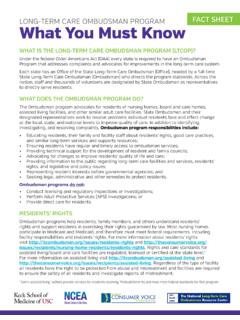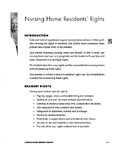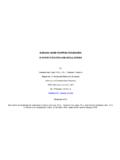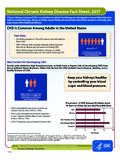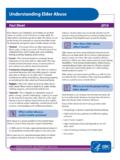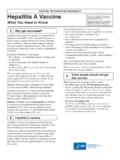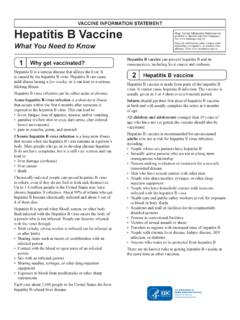Transcription of PROGRAM AND PRACTICE - ltcombudsman.org
1 PROGRAM MANAGEMENT: TRAINING FOR OMBUDSMAN PROGRAM REPRESENTATIVES One of the first steps in PROGRAM management is defining training requirements for Ombudsman PROGRAM representatives (staff and volunteers) working in assisted living facilities (ALFs).1 This resource highlights key elements to include in training for Ombudsman PROGRAM advocacy in ALFs (in addition to initial certification training that addresses the history, role, and responsibilities of the PROGRAM ).2 Due to the lack of federal regulations, state definitions and regulations for board and care homes or assisted living facilities vary and Ombudsman programs will need to modify their training materials to reflect state specific information.
2 Key Training Elements Describe the Setting What are the names used in your state to categorize care homes which do not meet the definition of a nursing home? ( , assisted Living, board and care, personal care home, etc.) What are the characteristics of this type of care? ( , number of residents, type of care permitted, etc.) Include the state law/regulations which describe these homes. Describe Medicaid and other government payment sources available in your state ( , Medicaid waivers (HCBS), Veteran s benefits, etc.). Include your state statistics regarding individuals living in assisted living that are Medicaid beneficiaries or using another benefit to receive services.
3 O If applicable, here are some resources to educate representatives regarding the Home and Community Based Services (HCBS) Settings Final Rule (2014):3 Department of Health and Human Services Medicaid Home and Community Based Services webpage Overview of HCBS Settings Rule Key Provisions of the Final HCBS Settings Rule (January 10, 2014) o The final rule includes requirements for provider-owned or controlled home and community-based residential settings. These requirements include: The individual has a lease or other legally enforceable agreement providing similar protections; The individual has privacy in their unit including lockable doors, choice of roommates and freedom to furnish or decorate the unit.
4 1 Due to the variation in facility type, terminology and licensure for these facilities by states the term assisted living facilities (ALFs) is used in this compendium to refer to all non-nursing homes covered by the Ombudsman PROGRAM such as: board and care facilities, residential care homes, adult foster care homes, and personal care homes. 2 Training for Ombudsman PROGRAM representatives is critical for maintaining an effective PROGRAM . The National Long-Term Care Ombudsman Resource Center develops and collects materials and information that enhance and strengthen the training of paid and volunteer ombudsmen.
5 The NORC Curriculum is designed to help states improve their basic training for PROGRAM representatives and the teaching methods are based on principles of adult learning and grounded in Ombudsman PROGRAM values and responsibilities. The curriculum and other training materials are available on the NORC website: 3 Links to resources in this section are ; CMS Fact Sheet Overview of HCBS Settings Rule- ; CMS Fact Sheet, Summary of Key Provisions- ; NORC HCBS webpage- PROGRAM AND PRACTICE : LTCOP ADVOCACY IN ASSISTED LIVING FACILITIES 2 The individual controls his/her own schedule including access to food at any time; The individual can have visitors at any time; and The setting is physically accessible.
6 O For more information regarding the HCBS Settings Rule, including training materials, visit the NORC HCBS webpage. Understanding the Authority What federal authority allows Ombudsman to advocate on behalf of residents in these homes? The Older Americans Act (OAA) defines long-term care facilities as skilled nursing facilities, nursing facilities, board and care facilities and other adult care homes. The OAA states that LTCO must ensure residents of long-term facilities have regular and timely access to LTCO services and that the residents and complainants receive timely responses from representatives of the LTCO All the LTCO functions, duties, and other requirements ( , resident access to PROGRAM services, complaint resolution, systems advocacy, community education, information and assistance) outlined in the OAA apply to LTCO services for residents of all long-term care facilities.
7 Some of the Older Americans Act provisions regarding LTCO responsibilities to assist individuals living in long-term care facilities are OLDER AMERICANS ACT OF 1965 [Public Law 89 73] [As Amended Through 114 144, Enacted April 19, 2016] SEC. 102. (35) The term long-term care facility means (A) any skilled nursing facility, as defined in section 1819(a) of the Social Security Act (42 1395i 3(a)); (B) any nursing facility, as defined in section 1919(a) of the Social Security Act (42 1396r(a)); (C) for purposes of sections 307(a)(12) 1 and 712, a board and care facility; and (D) any other adult care home, including an assisted living facility, similar to a facility or institution described in subparagraphs (A) through (C).
8 The word older was removed from the definition of resident in the 2016 reauthorization of the SEC. 711(6) RESIDENT The term resident means an individual who resides in a long-term care facility. The Older Americans Act requires that annual State LTCO reports include an analysis of the state LTCO PROGRAM s services to residents of assisted living facilities. SEC. 712. STATE LONG-TERM CARE OMBUDSMAN PROGRAM . (h)(E)(i) analyzing the success of the PROGRAM including success in providing services to residents of board and care facilities and other similar adult care facilities Long-Term Care Ombudsman PROGRAM Final Rule There are many references to ALFs in the LTCOP Final Rule and in the Analysis of Comments.
9 Background - State Long-Term Care Ombudsman programs (Ombudsman programs ) serve as advocates for residents of nursing homes, board and care homes, assisted living and similar adult care facilities. 4 Older Americans Act of 1965. Section 102 (a)(35) and Section 712 (a)(3)(D). 5 More information regarding the OAA is available on the NORC website 6 See 2016 Older Americans Act Reauthorization FAQ for more information Also, prior to the definition change in the OAA, the guidance in Department of Health and Human Services, Administration on Aging, PROGRAM Instruction (PI) 81-8, said that Ombudsman programs may provide services to all residents regardless of age if the complaint impacts other residents in the facility ( ).
10 3 They work to resolve problems of individual residents and to bring about improvements to residents' care and quality of life at the local, state and national levels. The OAA provides authority for the Ombudsman PROGRAM to serve residents living in long-term care facilities as defined at Section 102(35) of the Act ( nursing facilities, board and care homes, assisted living, and similar adult care facilities). We note that historically Congress changed the title of Nursing Home Ombudsman to Long-Term Care Ombudsman in the 1981 reauthorization of the OAA, expanding the service population to include residents of board and care residents and other similar adult care facilities.
